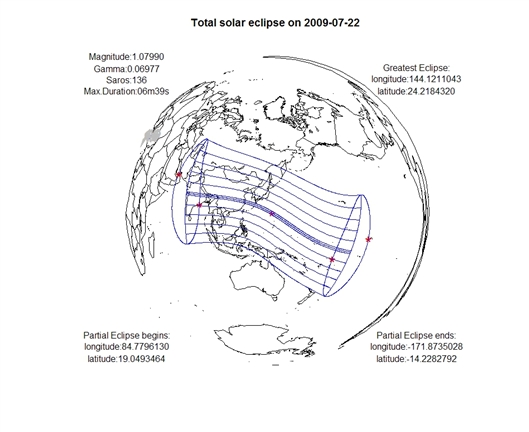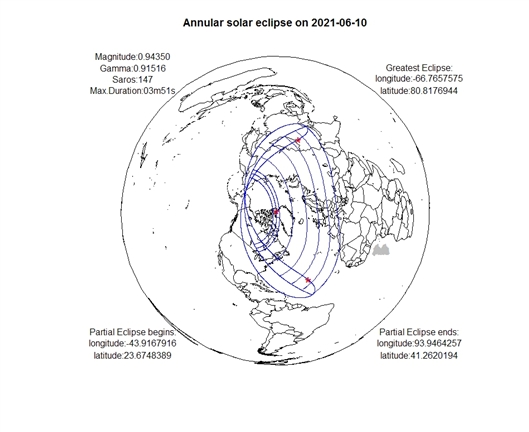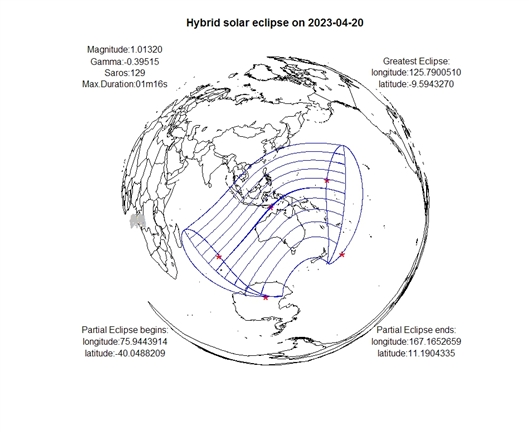1
2
3
4
5
6
7
8
9
10
11
12
13
14
15
16
17
18
19
20
21
22
23
24
25
26
27
28
29
30
31
32
33
34
35
36
37
38
39
40
41
42
43
44
45
46
47
48
49
50
51
52
53
54
55
56
57
58
59
60
61
62
63
64
65
66
67
68
69
70
71
72
73
74
75
76
77
78
79
80
81
| plotkml <-
function(file, projection = "azequalarea" , parameter = NULL, grid = TRUE, info = TRUE,... ){
require(maptools)
require(mapproj)
require(mapdata)
zz <- getKMLcoordinates(file, ignoreAltitude = TRUE)
x11(11,9)
m <- map('world',proj= projection, parameter = parameter, orient=c(zz[[1]][2], zz[[1]][1], 0), ...)
for(i in 1:length(zz)){
if(is.data.frame(zz[[i]])){
if(ncol(zz[[i]]) > 3){
i = i + 1
}
}
if(is.list(zz[[i]])){
i = i + 1
}
if(is.vector(zz[[i]])){
points(mapproject(list(y = zz[[i]][2], x= zz[[i]][1])), pch = "*", cex = 2, col = 2)
}
if(is.matrix(zz[[i]])){
lines(mapproject(list(y = zz[[i]][,2], x= zz[[i]][,1])), col = "blue", ...)
}
}
if(grid){
map.grid(m, lty = 1, col = "grey")
}
file1 <- readLines(file)
if(title){
daterecord <- file1[grepl("when", file1)]
date <- substring(gsub(" ", "", daterecord), 7, 16)
type <- file1[grepl("Type:", file1)]
stype <- gsub(" ", "", type)
typesolar <- substring(stype, 12, regexpr("<br", stype) - 1)
title(paste(typesolar, "solar eclipse on", date))
}
if(info){
bg <- which(grepl("<li>Magnitude:", file1))
info <- file1[bg:(bg+4)]
infosub <- gsub("</li>", "", gsub(" ","",gsub("<li>", "",gsub(" ", "", info))))
text(-1.3, seq(1.4, 1.1, by = -0.1),infosub[1:4])
bg <- min(which(grepl("<name>P1", file1)))
sub <- file1[bg:(bg+100)]
ind <- min(which(regexpr("<longitude>",sub)>0))
info <- sub[c(ind, ind +1)]
info1 <- gsub("de", "de:",gsub("/longitude","",gsub("/latitude", "", gsub("[<->]", "", gsub(" ", "",info)))))
information <- c("Partial Eclipse begins:", info1)
text(-1.3,seq(-1.1, -1.3, by = -0.1),information)
bg <- min(which(grepl("last external", file1)))
sub <- file1[bg:(bg+100)]
ind <- min(which(regexpr("<longitude>",sub)>0))
info <- sub[c(ind, ind +1)]
info1 <- gsub("de", "de:",gsub("/longitude","",gsub("/latitude", "", gsub("[<->]", "", gsub(" ", "",info)))))
information <- c("Partial Eclipse ends:", info1)
text(1.3,seq(-1.1, -1.3, by = -0.1),information)
bg <- min(which(grepl("Greatest Eclipse Point", file1)))
sub <- file1[bg:(bg+100)]
ind <- min(which(regexpr("<longitude>",sub)>0))
info <- sub[c(ind, ind +1)]
info1 <- gsub("de", "de:",gsub("/longitude","",gsub("/latitude", "", gsub("[<->]", "", gsub(" ", "",info)))))
information <- c("Greatest Eclipse:", info1)
text(1.3,seq(1.3, 1.1, by = -0.1),information)
}
}
|








